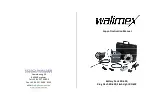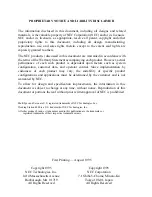
Your appliance should be repaired by an electrician
only!
This appliance meets the appropriate safety provisions.
Repairs may only be executed by an electrician and
original spare parts must be used, otherwise the user may
face a risk of injury.
Appliance-specific safety instructions
•
Instructions of the charged battery manufacturer,
especially the acid state and distilled water refilling,
must necessarily be followed.
•
Always wear protective glasses and gloves for
this work.
•
Good ventilation around the battery and charger must
be provided.
•
Never start the engine when the charger is
connected.
•
The cover cannot be opened under any
circumstances. The charger must not be used any
longer if the cover is damaged.
•
Charge the batteries at temperatures above 0°C.
•
Before putting the appliance into operation, check
whether the voltage and current details on the
charger output side correspond to the connected
battery or accumulator.
•
Make sure no other items can cause short circuit on
the appliance contacts.
•
Make sure the red and black terminals never touch
each other.
•
Lay all cables in a way to prevent a risk of trip and
avoid cable damage!
•
Never pull the plug out of socket by cable.
•
Unplug the appliance
- before cleaning
- every time the appliance has been used
•
Children are unable to estimate the risk arising from
electric devices. In any case, do not let children use
electric devices.
•
Persons whose physical, sensory and mental abilities
or lack of knowledge make operating the appliance
impossible must not use it.
•
Risk of fatal electric shock!
•
Never touch exposed conductors with bare hands.
That applies, in particular, for alternating current
circuit conductors.
•
When working on electrical equipment, make sure
there is a person around who will help you if
necessary.
•
To unplug the appliance quickly in case of
emergency, the plug must be near the appliance and
easily accessible.
•
Before putting the appliance into operation, make
sure the feeder cable and plug are dry.
•
Please remember that some parts of the appliance
may remain under voltage after the protective device
(protection) has been engaged.
•
Put the appliance in a dry place protected against
spraying water.
•
Protect the appliance against aggressive vapours and
air containing moisture or salts.
•
Protect the appliance and cables against rain and
moisture.
•
Do not put the cables on items with sharp edges.
•
Do not put the cable in a way it is broken at a sharp
angle.
•
Do not pull the cable.
•
Provide good ventilation.
•
From all sides of the charger, keep a minimum
distance of 20 cm from other items.
•
Keep all items that could get damaged as a result of
high temperatures in a sufficient distance when the
appliance is being operated.
•
Do not use the appliance in an environment
with flammable gases, e.g. in bilges of boats powered
by petrol or near propane tanks.
•
Switch the appliance off after being used.
•
Check regularly the charger when charging or when
charging is maintained.
•
Charging batteries to be used only.
•
Boat batteries to be charged outside the boat only.
•
Risk of injury! Batteries may contain
aggressive and caustic acids. Avoid any contact of
your body with the battery liquid. If you stain yourself
with the battery liquid, the given body part needs to
be washed thoroughly with water.
•
Risk of explosion! Prevent metal items from falling on
the battery. It could cause sparking or short circuit on
the battery and other electric components.
•
Risk of explosion! Appropriate polarity must
be ensured for the connection – red terminal: positive
pole – black terminal: negative pole.
•
Wear protective glasses and clothes when
working with the batteries.
•
Do not touch your eyes when working with the
battery.
•
Make sure good stability is provided! The appliance
and the battery being charged need to be placed in a
safe way to ensure they do not fall down or turn over.
•
Follow the battery manufacturer instructions and
instructions of the manufacturer of the appliance or
vehicle where the battery is used.
•
Never try to charge batteries that are frozen.
•
Do not smoke and make sure there are no
sparks near the battery.
•
If the battery needs to be removed, the ground must
be disconnected first. Before removing the battery,
disconnect all connections and appliances from the
battery.
•
Do not charge standard batteries.
•
Caution! Risk of imminent risk of explosion
when there is penetrating smell of gas. Switch the
appliance off and unplug it, ventilate immediately and
have the appliance and battery checked by a
professional.
Use as designated
The automatic battery charger has been designed to
charge 12V starting batteries (lead acid batteries, gel
batteries, AGM). Any other use is in conflict with the
designation. The manufacturer will not be responsible for
any indirect damages and injuries. Please be sure to know
that our appliances have not been designed to be used for
industrial purposes. Any help when starting or during high-
rate charging is not possible.
Putting the appliance into operation
Step 1
Loosen or remove the battery plugs (if applicable) and find
out the acid level of the charged battery.
Instructions of the charged battery manufacturer,
especially the acid level and distilled water refilling, must
9
Содержание 85057 GAB 5A
Страница 2: ...A B 2 1 3 4 1 2 3 4 5 6 7 8 ...










































